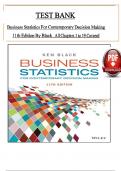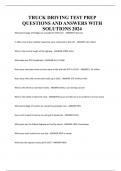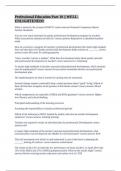,TABLE OF CONTENTS
1 Introduction to Statistics and Business Analytics
2 Visualizing the Data with Charts and Graphs
3 Descriptive Statistics
4 Probability
5 Discrete Distributions
6 Continuous Distributions
7 Sampling and Sampling Distributions
8 Statistical Inference: Estimation for Single Populations
9 Statistical Inference: Hypothesis Testing for Single Populations
10 Statistical Inferences About Two Populations
11 Analysis of Variance and Design of Experiments
12 Simple Regression Analysis and Correlation
13 Multiple Regression Analysis
14 Building Multiple Regression Models
15 Time-Series Forecasting and Index Numbers
16 Analysis of Categorical Data
17 Nonparametric Statistics
18 Statistical Quality Control
19 Decision Analysis
,Business Statistics, 11e (Black)
Chapter 1 Introduction To
Statistics
1) Virtually All Areas Of Business Use Statistics In Decision
Making. Answer: TRUE
Diff: 1
Response: See Section 1.1 Basic Statistical Concepts
Learning Objective: 1.1: List Quantitative And Graphical Examples Of Statistics Within A
Business Context.
2) Statistics Can Be Used To Predict Business In The
Future. Answer: TRUE
Diff: 1
Response: See Section 1.1 Basic Statistical Concepts
Learning Objective: 1.1: List Quantitative And Graphical Examples Of Statistics Within A
Business Context.
3) Statistics Are Used To Market
Vitamins. Answer: TRUE
Diff: 1
Response: See Section 1.1 Basic Statistical Concepts
Learning Objective: 1.1: List Quantitative And Graphical Examples Of Statistics Within A
Business Context.
4) A List Of Final Grades In An Introductory Class In Business Is An Example Of
Statistics. Answer: FALSE
Diff: 1
Response: See Section 1.1 Basic Statistical Concepts
Learning Objective: 1.1: List Quantitative And Graphical Examples Of Statistics Within A
Business Context.
5) A Graph Of Purchases Made From One Store Location Would Be An Example Of Statistics
Within A Business Context.
Answer: TRUE
Diff: 1
Response: See Section 1.1 Basic Statistical Concepts
Learning Objective: 1.1: List Quantitative And Graphical Examples Of Statistics Within A
Business Context.
6) The Complete Collection Of All Entities Under Study Is Called The
Sample. Answer: FALSE
Diff: 1
Response: See Section 1.1 Basic Statistical Concepts
Learning Objective: 1.2: Define Important Statistical Terms, Including Population, Sample, And
Parameter, As They Relate To Descriptive And Inferential Statistics.
1
, 7) A Portion Or Subset Of The Entities Under Study Is Called The
Statistic. Answer: FALSE
Diff: 1
Response: See Section 1.1 Basic Statistical Concepts
Learning Objective: 1.2: Define Important Statistical Terms, Including Population, Sample, And
Parameter, As They Relate To Descriptive And Inferential Statistics.
8) A Descriptive Measure Of The Population Is Called A
Parameter. Answer: TRUE
Diff: 1
Response: See Section 1.1 Basic Statistical Concepts
Learning Objective: 1.2: Define Important Statistical Terms, Including Population, Sample, And
Parameter, As They Relate To Descriptive And Inferential Statistics.
9) A Census Is The Process Of Gathering Data On All The Entities In The
Population. Answer: TRUE
Diff: 1
Response: See Section 1.1 Basic Statistical Concepts
Learning Objective: 1.2: Define Important Statistical Terms, Including Population, Sample, And
Parameter, As They Relate To Descriptive And Inferential Statistics.
10) Statistics Is Commonly Divided Into Two Branches Called Descriptive Statistics And
Summary Statistics.
Answer: FALSE
Diff: 1
Response: See Section 1.1 Basic Statistical Concepts
Learning Objective: 1.2: Define Important Statistical Terms, Including Population, Sample, And
Parameter, As They Relate To Descriptive And Inferential Statistics.
11) A Descriptive Measure Of The Sample Is Called A
Statistic. Answer: TRUE
Diff: 1
Response: See Section 1.1 Basic Statistical Concepts
Learning Objective: 1.2: Define Important Statistical Terms, Including Population, Sample, And
Parameter, As They Relate To Descriptive And Inferential Statistics.
12) Gathering Data From A Sample To Reach Conclusions About The Population From
Which The Sample Was Drawn Is Called Descriptive Statistics.
Answer: FALSE
Diff: 2
Response: See Section 1.1 Basic Statistical Concepts
Learning Objective: 1.2: Define Important Statistical Terms, Including Population, Sample, And
Parameter, As They Relate To Descriptive And Inferential Statistics.
2








